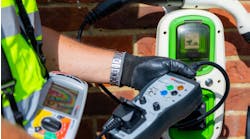Four kinds of insulation resistance tests are particularly useful. Two of these tests include:
- Time resistance. This method consists of trending a series of readings taken at fixed intervals. If you have no insulation resistance history, then this method can help you make a reliable assessment. If the insulation is sound, the trending graph shows an increasing level of resistance.
- Dielectric absorption ratio. With this method, you perform two time resistance (TR) tests, and then divide the readings of one by the other to obtain a ratio. Two common ratios are a 10-min TR divided by a 1-min TR, and a 60-sec TR divided by a 3- sec TR. That first ratio gives you the "polarization index" established in IEEE Standard 43-2000 in 1974. That index provides a standardized way of using the data and is worth learning more about.
The manual for your insulation resistance tester provides specifics on these tests, as does the manufacturer's Web site. We'll discuss two other tests in the next issue of this e-newsletter.
Voice your opinion!
Voice your opinion!
To join the conversation, and become an exclusive member of EC&M, create an account today!
Sponsored Recommendations
Sponsored Recommendations
Latest from Test & Measurement
Latest from Test & Measurement
Sponsored
Sponsored


